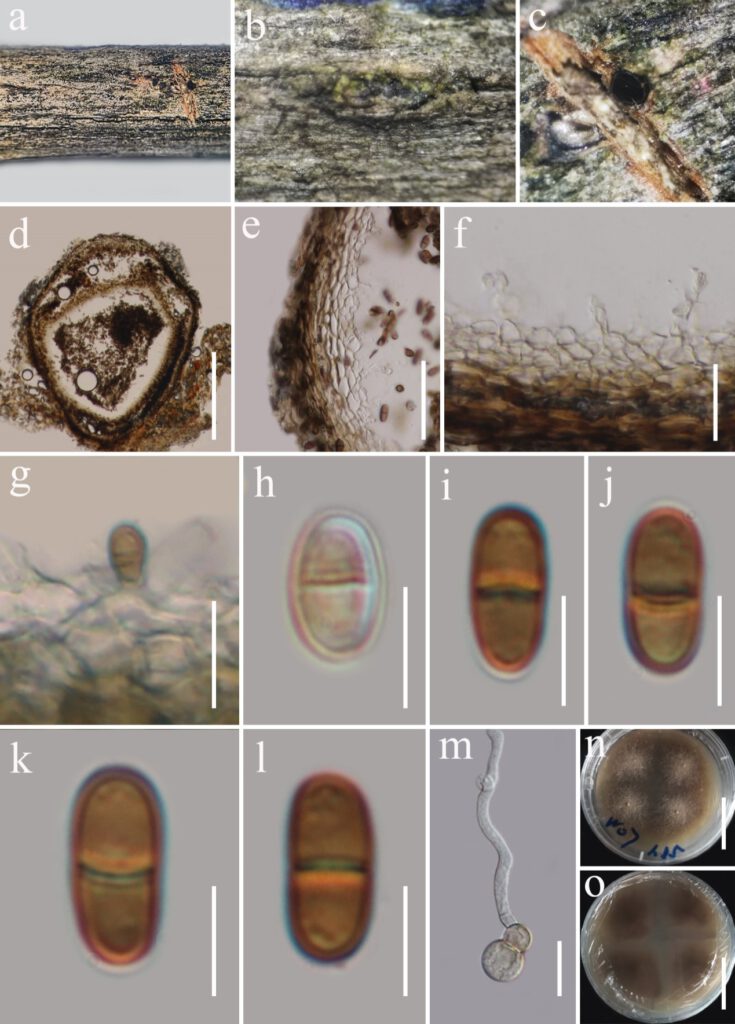Karstenula lancangensis G.C. Ren & K.D. Hyde, sp. nov. Fig. 7
MycoBank number: MB; Index Fungorum number: IF; Facesoffungi number: FoF 10706;
Etymology ‒ The species epithet “lancangensis” refers to where the species was collected.
Holotype ‒ KUN-HKAS 122790
Saprobic on dead woody twigs of Cinnamomum glanduliferum (Lauraceae). Sexual morph: Undetermined. Asexual morph: Conidiomata 270–480 µm high × 240–430 µm diam. (x̅ = 410 × 350 µm, n = 5), pycnidial, solitary, immersed, unilocular or bilocular, obpyriform, black conidiomata formed under the bark, with broadly rounded apex, and a broad pore opening. Conidioma wall 30–40 µm wide, 4–6 layers, composed of an outer layer of brown cells and an inner layer of hyaline cells of textura angularis. Conidiophores reduced to conidiogenous cells. Conidiogenous cells 4–6.5 × 4.4–6.4 μm (x̅ = 5.3 × 5.4 µm, n = 15), holoblastic, ampulliform to doliiform, determinate, hyaline, with conspicuous periclinal thickening. Conidia 8–10 × 3–4 μm (x̅ = 8.8 × 3.6 µm, n = 30), cylindric, straight, initially hyaline, becoming brown at maturity, 1-septate at median, the septum partly dark brown, not constricted at septum, tip and base rounded, thick-walled, smooth.
Culture Characters ‒ Colonies on PDA, reaching 45–50 mm diam. at 14 days at room temperature (25–30 ℃), superficial, with sparse mycelia, circular, rough, granular, gray-white; reverse dark brown.
Known distribution ‒ dead woody twigs of Cinnamomum glanduliferum. (China).
Material examined ‒ Chian, Yunnan Province, Lancang, Lahu Autonomous Prefecture, Hani (22°24.381’N, 100°06.647’E, elevation 900 m), on dead woody twigs of Cinnamomum glanduliferum, 23 March 2020, G.C. Ren, W07 (KUN-HKAS 122790, holotype), ex-type culture KUMCC 21-0670.
Notes ‒ Karstenula lancangensis is introduced as a new species based on its distinct morphology and the combined phylogeny of the SSU, LSU, ITS, and tef1-α dataset. In the phylogenetic analyses, Karstenula lancangensis formed a sister clade to K. rhodostoma with strong support (100% ML, 1.00 PP; Fig. 1). Karstenula lancangensis shows similar morphological features to K. rhodostoma in having cylindric, 1-septate, brown conidia. However, the size of the conidia of Karstenula lancangensis (8–10 × 3–4 μm) are comparatively smaller than those of K. rhodostoma (10–) 11–13 (–14) × (4–) 4.5–5 (5.5) µm). In addition, the conidiomata of Karstenula lancangensis are unilocular or bilocular, obpyriform with a broadly rounded apex and broad pore, while the conidiomata of K. rhodostoma are unilocular, globose with a 100 × 80 μm ostiole (Constantinescu 1993).

Figure 7 ‒ Karstenula Lancangensis (KUN-HKAS 122790, holotype) a–c Conidiomata on the natural wood surface. d–e Sections through conidiomata. f Conidioma wall. h Conidiogenous cells and developing conidia. h–l Conidia. m Germinated conidium. n, o Culture characters on PDA. Scale bars: d = 200 μm, e = 40 μm, f = 20 μm, g = 10 μm, h–m = 5 μm, n, o = 30 mm.
